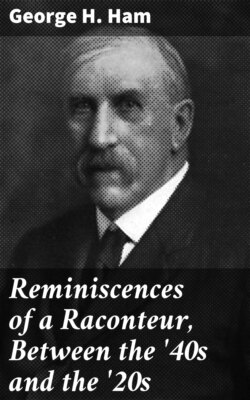Читать книгу Reminiscences of a Raconteur, Between the '40s and the '20s - George H. Ham - Страница 19
На сайте Литреса книга снята с продажи.
CHAPTER III
ОглавлениеTable of Contents
Winnipeg a City of Live Wires—Three Outstanding
Figures—Rivalry Between Donald A. and Dr.
Schultz—Early Political Leaders—When Winnipeg
was Putting on its First Pants—Pioneer
Hotels—The Trials of a Reporter—Not Exactly
an Angelic City—The First Iron
Horse—Opening of the Pembina Branch—Profanity
by Proxy—The Republic
of Manitoba—The Plot to Secede.
Winnipeg is a live wire city. That does not have to be proven. Almost any one of its progressive business men will admit that, if cornered, but it is doubtful if in its couple of hundred thousand or so of people it holds as many distinguished “live wires” as did the muddy, generally disreputable village that in, say, 1873, with a thousand or perhaps fifteen hundred people, straggled along Main Street from Portage Avenue to Brown’s Bridge, near the present site of the City Hall, and sprawled between Main Street and the river. It was without sidewalk or pavements; it had neither waterworks, sewerage nor street lights. The nearest railroad was at Moorhead on the Red River, 222 miles away. Its connection with the outer world was one, or possibly two, steamers on the Red River in the summer, and by weekly stage in winter. It boasted telegraph connection with the United States and Eastern Canada by way of St. Paul, during the intervals when the line was working. Although essentially Canadian it was practically cut off from direct connection with Canada. The Dawson route to Port Arthur could be travelled with great labor, pains and cost; but did not admit of the transportation of supplies. All freight came by Northern Pacific Railway to Moorhead; then by steamer, flat boat or freight team to Winnipeg.
But the Winnipeg of that day was recognized to be then, as it is now, the gateway to the Canadian Prairie West where lay the hope of Canada’s future greatness. The transfer of governmental authority over Rupert’s Land from the Hudson’s Bay Company to Canada had taken place in 1869; Canadian authority had been established by the first Red River expedition of 1870; a transcontinental railway was to be built at an early date that would displace the primitive conditions then existing. The doors of vast opportunity lay wide open and Canada’s adventurous sons flocked to Winnipeg to have a part in the great expansion—the building of a newer and greater Canadian West. They were big men, come together with big purpose. Their ideas were big, and they fought for the realization of them. They struggled for place and power and advantage, not with regard to the little, isolated village which was the field of their activities and endeavors; but always with an eye to the city that now is and to the great plains as they now are.
They saw what was coming; they were there to bring it. Yet those who lived to see their visions realized, as they are to-day, are few and far between. The boom of 1881 seemed to promise that realization, while the pioneers of the early ’70’s were still to the fore. But the promise of the boom was not fulfilled—then. It was only a mirage, and when it passed it left the majority of the pioneers blown off the map financially and otherwise. And few ever “came back”. Since the boom of 1882, the soul of Winnipeg has never been what it was before. The later Winnipeg may be a better city. It was a short life from ’71 to ’82, but while it lasted, it was life with a “tang” to it—a “tang” born of conditions that cannot be repeated and therefore cannot be reproduced.
